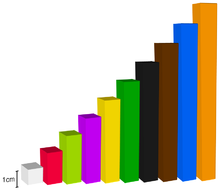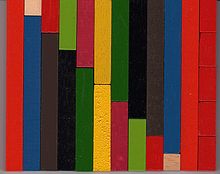- Cuisenaire rods
-
Cuisenaire rods give students a hands-on[1] elementary school way to learn elementary math concepts, such as the four basic arithmetic operations and working with fractions.[2]
One of the first educators to use rods to represent the numbers 1 to 10 was Maria Montesorri. In the earl 1950s, Caleb Gattegno popularized a standard set of colored number rods created by Georgies Cuisenaire, a Belgian who called the rods réglettes.
Contents
Overview
The rods (in the original French) are named after their inventor, Georges Cuisenaire (1891-1976), a Belgian primary school teacher, who published a book on their use in 1952 called Les nombres en couleurs. The use of rods for both mathematics and language teaching was developed and popularised by in many countries around the world.
Though primarily used for mathematics, they have also become popular in language-teaching classrooms, particularly The Silent Way.[3] They can be used to teach items such as prepositions of place, sentence and word stress.
Colour Length
(in centimeters)White 1 Red 2 Light green 3 Lavender 4 Yellow 5 Dark green 6 Black 7 Brown 8 Blue 9 Orange 10 Other coloured rods
In her first school, and in schools since then, Maria Montessori used coloured rods in the classroom to teach concepts of both mathematics and length. This is possibly the first instance of coloured rods being used in the classroom for this purpose.
Doctor Catherine Stern also devised a set of coloured rods produced by staining wood with aesthetically pleasing colours.
In 1961 Seton Pollock produced the Colour Factor system, consisting of rods from lengths 1 to 12 cm. The odd-numbered lengths have cold colours, and the even-numbered lengths have warm colours.
References
- ^ "In 1953, Dr. Caleb Gattegno, a mathematics professor at the University of London, visited Georges Cuisenaire. Dr. Gattegno realized that Cuisenaire’s rods provided teachers with a means for making mathematics learner-centered and an active, hands-on experience for every pupil" Cuisenaire® Rods Come To America
- ^ Teaching fractions with Cuisenaire rods
- ^ Silent Way Cuisenaire rods exercises
External links
- Cuisenaire Rods in the language classroom – article by John Mullen
- Online cuisenaire rods (NumBlox Freeplay)
Wikimedia Foundation. 2010.


